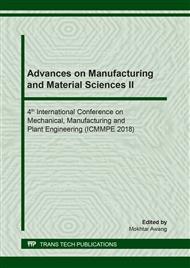p.3
p.11
p.17
p.22
p.30
p.38
p.46
p.53
p.62
Effects of Carbon Fiber Hybridization on the Compressive Strength of Glass-Carbon/Epoxy Hybrid Composite Pipes before and after Low Velocity Impact
Abstract:
In this paper, the effect of carbon fiber hybridization on the compressive strength of glass-carbon/epoxy hybrid filament wound pipes before and after low velocity impact was investigated experimentally. Specifically, the effects of different stacking sequence and fiber content ratio on the compression and compression after impact (CAI) behavior of hybrid glass-carbon fiber reinforced polymer pipes were analyzed. Hybrid composite pipes composed of eight layers of / reinforced with thin HDPE liner were manufactured utilizing filament winding technique. A series of axial compressive tests were carried out on the composite pipes for the non-impacted and impacted specimens under 100 J of impact energy. Residual compressive strength, damage tolerance and failure modes were examined and analyzed for different pipe configurations, before and after the impact. The failure modes of non-impacted and impacted composite pipes under compressive loading were analyzed visually. The results show that, under the same conditions of impact energy, specimens with alternative fibers exhibited better impact resistance regardless of fiber content ratio. Moreover, carbon fiber reinforced epoxy specimens exhibited the worst impact damage tolerance for a given impact energy level although having the highest compressive strength before impact among the samples, with the highest percentage reduction of 62% in residual compressive force after impact.
Info:
Periodical:
Pages:
30-37
Citation:
Online since:
March 2019
Authors:
Price:
Сopyright:
© 2019 Trans Tech Publications Ltd. All Rights Reserved
Share:
Citation:


